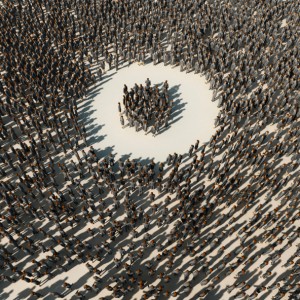The History of Histories (Part 9)
By Asher Crispe: November 9, 2012: Category Inspirations, Quest of the Question
The tetralogy of ‘temporal’ subversions of the Divine will (each relating to a different mode of Being as a letter in the Divine name Havayah) are predominately carried out by the Creator. These self-inflicted detours in the path to the intended goal add distance and therefore travel time. Why take the back road when the King’s highway will get you there quicker? Are we not ‘accidental tourists’ simply out to see the sites? Yet, many of us have at one time or another consciously elected to go the long way around precisely because it will afford us the opportunity to soak in the landscape and thereby cultivate our appreciation of it. Our destination becomes much more meaningful once we have an idea of how we got there. In fact, the process of working towards our destination is part of what makes the place. It places the place. Perhaps history is nothing more than the drinking of experiences along a circuitous heuristic route.
Our history is not a single story, but a multi-layer narrative which is encapsulated by the fourfold splinters in the Divine plan that we have been investigating. Let us now listen to our quartet once more to try to pick out and assign the various parts to distinct historical fields–the parallel histories from which History as a whole is woven.
1) Individual History
When we reflect upon the eating of the Tree of Knowledge by Adam and Chava/Eve we deal with their personal history. The event describes personal struggle. It is a story of choices and consequences, ruin and renovation–the hurdles in life. Each of us is an Adam facing a similar scenario, endeavoring to overcome the feelings of self-consciousness that hold us back privately and publicly. Personal history, which is most immediate as the closest horizon of human experience, discloses a tendency to become self-occupied, where the entire world collapses into one’s excessive concern for oneself–particularly in the face of others. Thus, our personal histories are all about our attempts at transcendence of the Ego. There is no magic pill. Self-refinement, which leads to concern and responsibility for the other, takes time. Each step of the way–be it progress or regress–adds to our character development.
2) Jewish History
As individuals we don’t generally dwell alone nor have we joined a united federation of planets or even a globalized government as citizens of earth. The next level of immediacy of our historical experience constructs the molecular and molar units of our social sphere. These include family, friends, tribes and peoples joined in common interests or shared histories. Quickly acquiring a sense of belonging, our socialization encloses us in a second skin.
Everyone speaks from somewhere. Even the Torah addresses the universal through the particular. This being the case, the focus on Jewish history is more generalized than that of an individual one but less universal than all of humanity. At the same time, the reflections on Jewish history are intended to map onto our individual biographies and inner experience just as they should speak to the universal human condition and the collective history of humanity.
Given this introduction, we can now explain that the Jewish people are likened to the moon whose cycles of waxing and waning reflect the collective Jewish historic position with respect to both the world at large and God. Just when the Jewish people seem to have disappeared and no moon is visible, we sense the start of a come back. Jewish resilience is renowned. However, for both inside and outside observers, one of the greatest Jewish challenges as a people has been relating authentic Jewish experience to others.
The diminishment of the moon represents the (historical) inadequacy of the Jewish people to present spirituality and the beauty of the Torah to others (and many times these others are other Jews). In essence, the moon is a broken communications relay. Consequently, Jewish history is the history of difficulties in expressing a ‘self’ as a family, tribe or people. Membership issues for instance create interior politics and exterior politics–the vertiginous self-other distinction. Holding sway over even kindred spirits has proven exceptionally challenging, let alone addressing the collective purpose and mission of revealing Divinity within Creation.
 What this model demonstrates is the complexity of relationships between the individual and the collective. When we spoke of individual history we would have to more properly refer to it as the level of the individual within the individual (the essentially individual). Jewish history therefore becomes paradigmatic of a personal-collective (a collective that I feel personally attached to) whereby it denotes the general within the particular. I as an individual also have a collective identity (family ancestry, geographic roots, national and ethnic attachments etc…). Rather than considering just my history (which is virtually impossible to isolate in and of itself), we must also contemplate my ‘personal-collective’ history and its (hopefully) celebrated differences and distinctions. By extension, the Torah informs us that there is a unique role to play in history by every personal-collective. From here we can begin to make sense of our tendency to view ourselves and others as part of a larger compounded historical identity–the self in society.
What this model demonstrates is the complexity of relationships between the individual and the collective. When we spoke of individual history we would have to more properly refer to it as the level of the individual within the individual (the essentially individual). Jewish history therefore becomes paradigmatic of a personal-collective (a collective that I feel personally attached to) whereby it denotes the general within the particular. I as an individual also have a collective identity (family ancestry, geographic roots, national and ethnic attachments etc…). Rather than considering just my history (which is virtually impossible to isolate in and of itself), we must also contemplate my ‘personal-collective’ history and its (hopefully) celebrated differences and distinctions. By extension, the Torah informs us that there is a unique role to play in history by every personal-collective. From here we can begin to make sense of our tendency to view ourselves and others as part of a larger compounded historical identity–the self in society.
In Part 10 we will deal with the next two levels of parallel histories, that of human history and cosmic history.
http://www.interinclusion.org/inspirations/the-history-of-histories-part-10/
http://www.interinclusion.org/inspirations/the-history-of-histories-part-8/
























;)
;)
;)
;)
;)
;)
;)
;)
;)
;)
